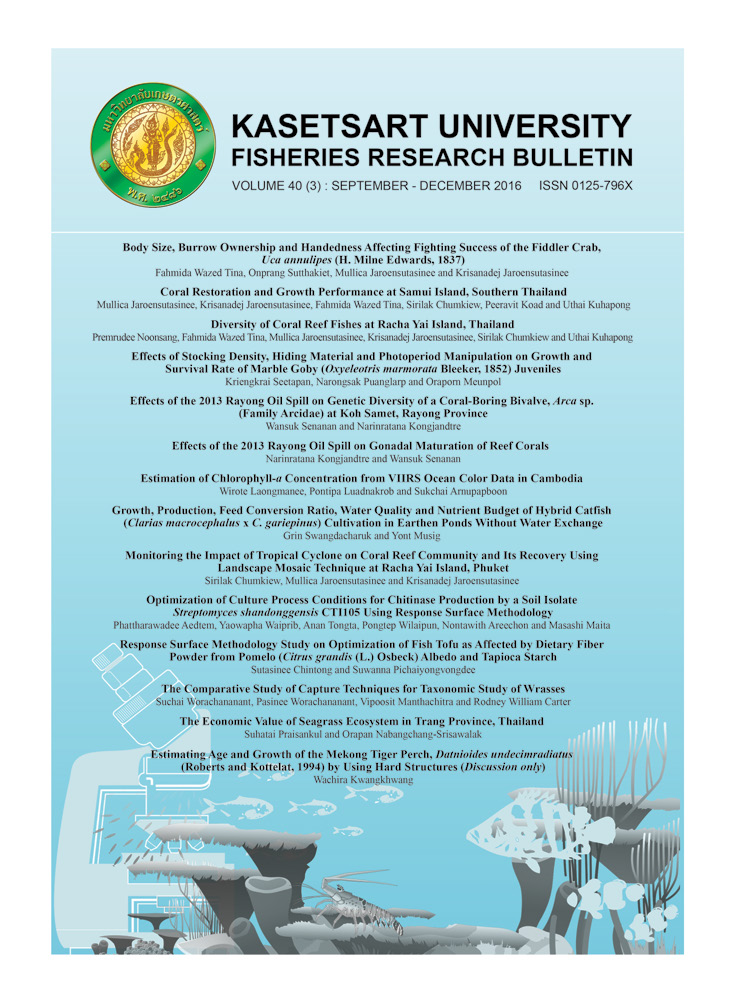Body Size, Burrow Ownership and Handedness Affecting Fighting Success of the Fiddler Crab, Uca annulipes (H. Milne Edwards, 1837)
Main Article Content
Abstract
In this study, the effects of body size, burrow ownership and handedness on fighting success of male fiddler crab, Uca annulipes (H. Milne Edwards, 1837) were investigated. Forty-six pairs of naturally engaged combats between residents and intruders were observed, and their fighting durations were recorded. After finishing each combat, the character of the winner (larger/smaller, resident/intruder) was identified, and afterwards the crabs were caught to identify their handedness (right/left claw), and to measure their carapace widths and major claw lengths. In addition, 40 non-fighting male crabs were caught randomly from the population, their handedness identified, and carapace widths and major claw lengths measured. Results showed that only larger males in the population were involved in combats. Residents, as well as, larger males won higher numbers of combats. Heteroclawed (opposite handed) combats were more common than homoclawed (same handed). Fighting duration was negatively correlated with body and claw size asymmetries of fighting pairs. This study clearly indicates that large resident males tend to win fights in a shorter time.
Article Details
References
2. Hackwell, P. R. Y., Passmore, N. I., 1996. Time constraints and multiple choice criteria in the sampling behaviour and mate choice of the fiddler crab, Uca annulipes. Behavioral Ecology and Sociobiology, 38, 407-416.
3. Christy,J. H., 1982. Burrow structure and use in the sand fiddler crab Ucapugilat (Bosc). Animal Behaviour, 30, 687-694.
4. Christy, J. H., Salmon, M., 1984. Ecology and evolution of mating systems of fiddler crabs (genus Uca). Biological Reviews, 59, 483-509.
5. Copeland, D. L., Levay, B., Sivaraman, B., Beebe-Fugloni, C., Earley, R. L., 2011.Metabolic costs of fighting are driven by contest performance in male convict cichlid fish. Animal Behaviour, 82, 271-280.
6. Hammerstein, P., Parker, G. A., 1982. The asymmetric war of attrition. Journal of Theoretical Biology, 96, 647-682.
7. Huntingford, F. A., Turner, A. K., 1987. Animal confilct. Chapman and Hall, London.
8. Hyatt, G. W., Salmon, M., 1978. Combat in the fiddler crabs Uca pugilator and U.pugnax: a quantitative analysis. Behaviour, 65, 182-211.
9. Jacobsson, S., Brick, O., Kullberg, C., 1995. Escalated fighting behaviour incurs predation risk. Animal Behaviour, 49, 235-238.
10. Jaroensutasinee, M., Tantichodok, P., 2003. Effects of size and residency on fighting outcomes in the fiddler crab, Uca vocans hesperiae (Decapoda, Brachyura, Ocypodidae). Crustaceana, 75, 1107-1117.
11. Jennions, M. D., Backwell, P. R. Y., 1996. Residency and size affect fight duration and outcome in the fiddler crab Uca annulipes. Biological Journal of the Linnean Society, 57, 293-306.
12. Le Boeuf: B. J., 1974. Male-male competition and reproductive success in elephant seals. American Zoologist, 14, 163-176.
13. Leimar, O., Enquist, M., 1984. Effects of asymmetries in owner-intruder conflicts. Journal of Theoretical Biology, 111, 475-491.
14. Mautz, B., Detto, T., Wong, B. B. M., Kokko, H., Jennions, M D., Backwell, P.RY., 2011. Male fiddler crabs defend multiple burrows to attract additional females. Behavioral Ecology, 22, 261-267.
15. Maynard Smith, J., 1982. Evolution and the theory of games. Cambridge University Press, Cambridge, pp.1-224.
16. Maynard Smith. J., Parker, G. A., 1976. The logic of asymmetric contests. Animal Behaviour, 24, 159-175.
17. Maynard Smith, J., Prince, G. R., 1973. The logic of the animal conflict. Nature, 246, 15-18.
18. Milner, R N. C., Booksmyth, I., Jennions, M D., Backwell, P. R. Y., 2010. The battle of the sexes? Territory acquisition and defence in male fiddler crabs. Animal Behaviour, 79, 735-738.
19. Morrell, L. J., Backwell, P.R. Y., Metcalfe, N. B., 2005. Fighting in fiddler crabs Uca mjoebergi: what determines duration? Animal Behaviour, 70, 653-662.
20. Neat, F.C., Huntingford, F.A., Beveridge, M. M. C., 1998. Fighting and assessment in male cichlid fish: the effects of asymmetries in gonadal state and body size. Animal Behaviour, 55, 883-891.
21. Parker, G.A., 1974.Assessment strategy and the evolution of fighting behaviour. Journal of Theoretical Biology, 47, 223-243.
22. Riechert, S. E., 1998. Game theory and animal contests. In: Dugat. kin Reeve, L.A.,(eds.), Game theory and animal behaviour. Oxford University Press, pp. 64-93.
23. Rosenberg, R. H., Enquist, M., 1991. Contest behaviour in Weidemeyer's admiral butterfly Limenitis weidemeyerii (Nymphalida): the effect of size and residency. Animal Behaviour, 42, 805-811.
24. Tma, F.W., Jaroensutasinee, M., Jaroensutasinee, K., 2015. Effects of body size, resident status and handedness on fighting behaviour of the fiddler crab, Uca bengali Crane, 1975. Crustaceana, 88, 775-789.
22. Waage, J. K., 1988. Confusion over residency and the escalation of damselfly territorial disputes. Animal Behaviour, 36, 586-595.


